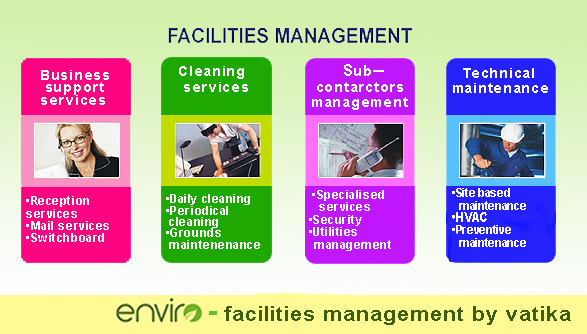The Function of Facility Management in Enhancing Operational Efficiency
The Function of Facility Management in Enhancing Operational Efficiency
Blog Article
The Vital Guide to Facility Monitoring: Approaches for Success
Center management plays an essential function in the total success of an organization, offering as the foundation that sustains effectiveness, performance, and safety and security. The nuances of effective center monitoring extend beyond simple logistics and call for a comprehensive understanding of both qualitative and measurable metrics.
Comprehending Center Monitoring
What comprises effective facility administration? Efficient center monitoring encompasses the coordination of different business functions to guarantee that developed atmospheres are risk-free, effective, and helpful to productivity. Facility Management. It integrates the principles of design, business, and design administration to develop a smooth operational flow within an organization
Trick elements of facility management include room preparation, upkeep administration, and compliance with health and wellness and safety regulations. Room preparation concentrates on optimizing making use of physical sources to support business goals, while upkeep management ensures that facilities are kept in optimum condition, taking full advantage of life-span and lowering operational costs. Compliance with lawful and regulative requirements is critical, as it safeguards the organization versus potential obligations and boosts its reputation.
Additionally, efficient center administration depends on the critical usage of innovation, such as Structure Management Solution (BMS) and Computer-Aided Facility Monitoring (CAFM) tools. These technologies promote real-time surveillance of structure systems and streamline maintenance processes. Eventually, an extensive strategy to facility management not just advertises functional efficiency yet also promotes a positive atmosphere for visitors and workers alike, driving general business success.
Key Strategies for Optimization
Enhancing facility management needs a critical approach that straightens operational exercise with organizational objectives. To attain this, the initial crucial strategy is the execution of integrated technological solutions. Using advanced software application systems permits for real-time tracking of center operations, assisting in data-driven decision-making and improving total performance.
Secondly, normal evaluations of facility efficiency are crucial. Carrying out routine examinations and audits allows facility managers to identify locations that require improvement, making certain that resources are assigned properly. This positive approach helps in decreasing downtime and boosting service distribution.
An additional essential strategy is cultivating collaboration throughout divisions. By motivating open communication between groups, center supervisors can much better align their strategies with business objectives, leading to improved functional harmony. Additionally, involving staff in training programs promotes a culture of accountability and enhances their ability to add to optimization initiatives.
Enhancing Safety And Security Procedures
Enhancing security procedures is vital for producing a safe and secure atmosphere within facilities. An extensive safety procedure not just safeguards workers and site visitors however also improves functional efficiency. To accomplish this, center supervisors should carry out routine threat evaluations to make sure and determine potential threats that proper steps are in area.
Training and education and learning are vital components of reliable security protocols - Facility Management. Employees need to get continuous training in emergency procedures, tools handling, and individual safety procedures. Regular drills, such as fire discharges or lockdown procedures, foster knowledge and preparedness amongst personnel
In addition, clear communication networks need to be established to report safety concerns quickly. This consists of producing an accessible platform for employees to articulate potential dangers or incidents without concern of reprisal. Leveraging modern technology can boost safety and security procedures; for example, executing surveillance systems and access controls aids monitor click here facility activities and limit unauthorized access.
Lastly, conformity with neighborhood guidelines and industry requirements is non-negotiable. Regular audits and testimonials of safety methods ensure placement with current regulations and finest methods. By focusing on these strategies, center supervisors can cultivate a culture of safety that secures all stakeholders and ultimately adds to the company's success.
Improving Workplace Environment

Ergonomic factors to consider are vital to lessen physical Facility Management strain and discomfort. Facility Management. This entails giving flexible furniture, proper illumination, and appropriate area for movement. These changes can result in lowered absence and enhanced work contentment
Aesthetic appeals play an important duty fit the office atmosphere. Utilizing color psychology, natural lights, and greenery can cultivate a promoting and welcoming environment. Thoughtfully created spaces can boost creative thinking and improve general well-being.
Moreover, encouraging employee interaction via inclusive decision-making procedures can boost the feeling of possession and belonging. Collecting feedback on office renovations and entailing workers in the style procedure can result in a more tailored setting that fulfills their requirements.
Lastly, advertising well-being efforts, such as wellness programs and leisure rooms, can better add to a supportive workplace culture. By concentrating on these strategies, facility managers can effectively boost the office setting, driving both employee satisfaction and business success.
Gauging Success in Facilities
Measuring success in center management needs a comprehensive strategy that examines both quantitative and qualitative metrics. Quantitative metrics typically include vital performance signs (KPIs) such as area usage prices, power consumption, upkeep prices, and occupancy degrees. These metrics offer a clear image of operational effectiveness and economic efficiency, allowing facility managers to recognize areas for enhancement and criteria versus industry standards.
Qualitative metrics, on the various other hand, concentrate on user satisfaction and worker involvement. Studies and feedback systems can evaluate just how well the facilities meet the demands of owners, helping to evaluate the general workplace environment. This element is crucial, as a completely satisfied labor force is often linked to boosted performance and retention prices.
To properly measure success, facility managers should likewise think about incorporating modern technology, such as constructing monitoring systems and information analytics devices, to accumulate and assess relevant information. Routinely evaluating both sets of metrics permits a more balanced sight of performance and notifies calculated decisions. Inevitably, an effective center monitoring method rests on a dedication to constant enhancement, ensuring that both operational efficiencies and user satisfaction are prioritized.
Verdict

Facility administration plays an essential function in the total success of an organization, offering as the foundation that supports productivity, security, and performance.Key aspects of center monitoring consist of space planning, upkeep management, and conformity with wellness and safety policies.Moreover, reliable center monitoring relies on the strategic use of innovation, such as Structure Monitoring Equipment (BMS) and Computer-Aided Center Management (CAFM) tools. Eventually, a comprehensive method to facility administration not only promotes operational website effectiveness however also promotes a positive environment for workers and visitors alike, driving overall organizational success.
Ultimately, a successful center monitoring approach pivots on a dedication to constant enhancement, making certain that both operational efficiencies and user satisfaction are focused on.
Report this page